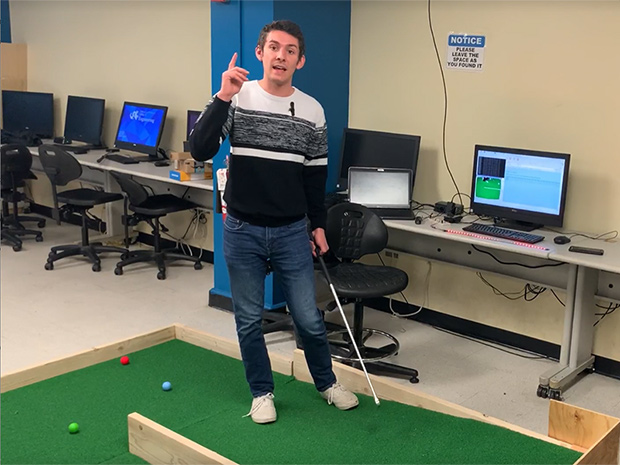
Declan Beaudoin
Playing miniature golf is a quintessential summer activity. The enduring experience from our childhoods remains unchanged... colorful golf balls, often goofy hole designs, rubber-coated putters and tiny, cumbersome pencils and scraps of paper for keeping score. Surely, there has to be a technological advancement that can help.
A team of fifth-year electrical engineering majors are hoping to find that way as part of their senior design projects. The group — Declan Beaudoin, Joshua Boniuk and Finn Clements — have designed a smart mini golf hole that can track players’ strokes, position of their golf balls on the course, know and identify who’s turn it is, and record when each player has sunk their putt.
The idea to develop scorekeeping technology, the team says, was inspired by a similar renaissance in bowling.
“In the early 90s, most neighborhood bowling alleys made you keep score on your own, and nobody quite understood how to do the math, so it was clumsy and frustrating,” Beaudoin explains. “Once automatic scoring became commonplace, the game exploded in popularity.”
The team considered several options for how to approach the problem. They tested accelerometers on the heads of their clubs and thought about taking inspiration from TopGolf, the popular driving range chain that uses chips in their golf balls and on the ground to track shots, but neither idea was close enough to the pin.
“We know that they use RFID chips in their golf balls, so even if we were able to replicate that, a mini golf course has too many balls in play at once, so it’s not realistic to track all of that,” Boniuk says. “So we started to think about putting a camera above each hole and connecting the camera to a computer that we could teach to identify and track each golf ball.”
Using a Rasberry PI and OpenCV, an open-source computer vision library, the team taught the camera to recognize each ball by color. The computer tracks the movement of each ball, records strokes, and sends the data to a web server that feeds a digital scorecard so players can keep track from their phones or other devices. It can even determine who’s turn is next based on what golf ball is furthest from the hole.
“We had to work together to figure out a practical solution that would work without over-complicating things. That’s an important skill to have no matter what field of engineering you’re in.”
Finn Clements
Once each player sinks a putt, sensors in the hole itself send data to the server to finalize that player’s score and move them onto the next hole. The team is even experimenting with using the sensors to create a celebratory light show when a player finishes the hole, similar to the video celebrations that play when bowlers get a strike or spare.
The team has so far built a single proof of concept hole and are welcoming friends and classmates to “play through” before taking a survey on how they enjoyed the experience versus traditional miniature golf. If the idea catches on, they are confident that it could scale to the size of a full 18-hole course.
“Mini golf is a good family activity and a great date activity,” Beaudoin shares. “If we can take away the awkward scorekeeping and let the game do that for you, you can focus on having a good time and being with the people you care about.”
The team says that the project challenged them to apply the problem-solving skills that they had learned over their previous four years.
“Some of our early solutions, like putting the accelerometer in the club head, were completely over-engineered,” Clements said. “We had to work together to figure out a practical solution that would work without over-complicating things. That’s an important skill to have no matter what field of engineering you’re in.”